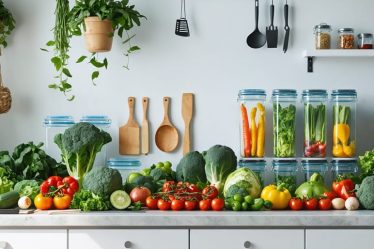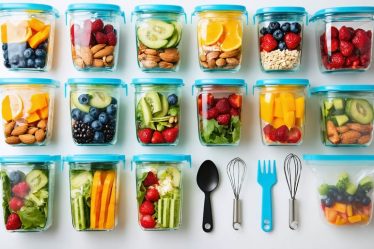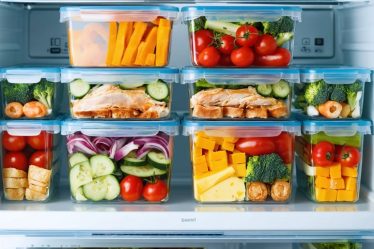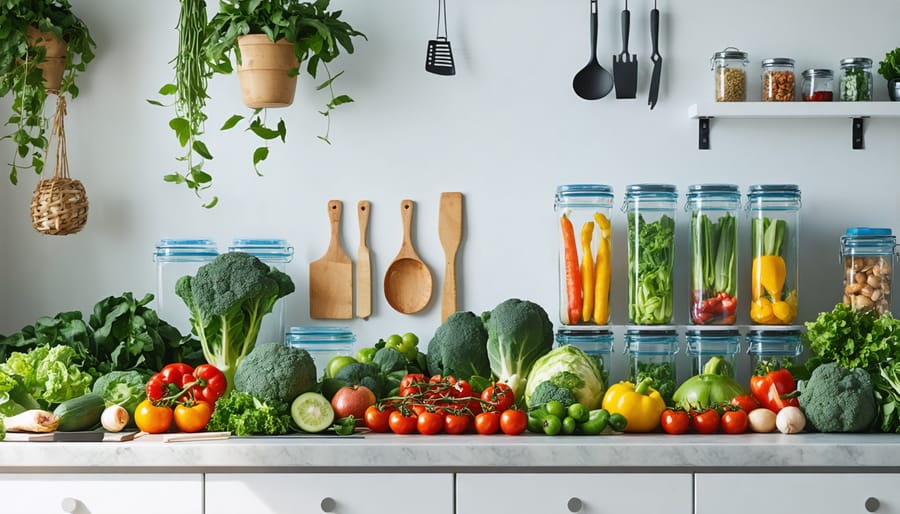
Transform your weekly meal routine with a strategic 7-day meal prep plan that saves time, reduces stress, and nourishes your body with seasonal ingredients. Imagine opening your fridge to find perfectly portioned, fresh meals ready to enjoy every day of the week – that’s the power of thoughtful meal preparation. Whether you’re a busy professional, health enthusiast, or simply looking to bring more organization to your kitchen, mastering the art of weekly meal prep revolutionizes how you approach cooking and eating.
Gone are the days of last-minute takeout or wondering “what’s for dinner?” By dedicating just 2-3 hours on a Sunday afternoon, you’ll create a week’s worth of delicious, nutrient-rich meals that align with your health goals and celebrate the season’s bounty. This comprehensive guide walks you through creating a sustainable meal prep routine that fits your lifestyle, budget, and dietary preferences, while making the most of nature’s changing harvest.
The secret lies in combining smart planning with efficient execution – think batch cooking seasonal vegetables, preparing versatile protein bases, and assembling mix-and-match components that keep meals exciting throughout the week. Ready to revolutionize your approach to weekly meals?
Why Seasonal Meal Prep Matters for Your Well-being
The Mindful Eating-Meal Prep Connection
When you think about meal prep, you might imagine it’s all about efficiency and saving time. However, it can also be a powerful tool to support your mindful eating practices. By planning and preparing meals in advance, you create intentional moments to connect with your food journey.
Picture this: instead of rushing through meal preparation when you’re already hungry and stressed, meal prep allows you to slow down and be present with each ingredient. As you wash those crisp vegetables, measure your portions, and combine flavors, you’re building a deeper appreciation for your food choices.
I’ve found that meal prep actually helps reduce mealtime anxiety. When you know exactly what’s waiting for you in the fridge, you’re less likely to make rushed decisions or mindlessly snack. Plus, the act of preparing food with intention sets a positive tone for the entire week.
Consider meal prep your mindfulness ritual – a time to reflect on your nutritional needs, honor your body’s signals, and create meals that truly nourish you. It’s about finding joy in the process, not just the end result.
Benefits of Eating with the Seasons
When I started incorporating seasonal sourcing into my meal prep routine, I discovered a world of benefits that went beyond just having fresh ingredients. Eating seasonally means enjoying produce at its peak flavor and nutritional value. Think of biting into a sun-ripened summer tomato or savoring sweet winter squash – there’s simply no comparison to out-of-season alternatives.
From a health perspective, seasonal eating aligns with our body’s natural nutritional needs. Winter vegetables are often rich in vitamin C and immune-boosting properties, while summer produce provides hydration and lighter nutrients perfect for warmer weather.
Your wallet will thank you too! Seasonal produce is typically more abundant and therefore more affordable. Plus, choosing local seasonal ingredients reduces transportation costs and environmental impact. I’ve found my grocery bills are notably lower when I shop with the seasons.
Another unexpected benefit? Seasonal eating keeps your meal prep exciting and varied throughout the year. It’s like nature’s way of ensuring we don’t get stuck in a culinary rut, constantly introducing new ingredients to experiment with.

Setting Up Your Seasonal Kitchen
Essential Tools and Storage Solutions
Let’s talk about the gear that’ll make your meal prep journey a breeze! As someone who’s learned through plenty of trial and error, I can tell you that having the right essential kitchen tools makes all the difference in creating an efficient meal prep routine.
Start with quality food storage containers – I recommend investing in a matching set of glass containers in various sizes. They’re perfect for both storing and reheating, plus you can easily see what’s inside. Grab at least 14 containers (two meals per day for seven days), and make sure they’re microwave-safe and leak-proof.
A few other must-haves include:
– Mason jars for overnight oats and salads
– Silicone muffin liners for portion control
– Heavy-duty sheet pans for roasting vegetables
– A good set of sharp knives
– Measuring cups and spoons
– Large mixing bowls
– A reliable food scale
Don’t forget about organization! Label makers and washable markers are fantastic for dating your containers. I also love using drawer organizers to keep everything tidy and easily accessible. A few large cooler bags are essential if you’re taking meals to work or running errands throughout the day.
Remember, you don’t need to buy everything at once – start with the basics and build your collection as you develop your meal prep routine.
Creating Your Seasonal Shopping List
One of my favorite parts of seasonal meal prep is creating a shopping list that truly celebrates what nature has to offer each season. I’ve found that starting with a quick browse through your local farmer’s market website or grocery store’s seasonal produce guide can be incredibly inspiring.
Begin by researching what fruits and vegetables are at their peak during the current season. For example, spring brings tender asparagus and sweet peas, while autumn offers hearty squashes and crisp apples. Create a master list of available seasonal produce, then cross-reference it with your favorite recipes to spark meal ideas.
I like to organize my seasonal shopping list into categories: proteins, seasonal produce, pantry staples, and herbs. This makes it easier to navigate both the grocery store and farmer’s market efficiently. Remember to consider storage life when planning – hardier vegetables like root vegetables and winter squash can last longer, while delicate greens should be used earlier in your meal prep week.
Pro tip: Keep a running list of seasonal ingredients on your phone or in a dedicated notebook. I’ve learned that noting which ingredients worked well in previous meal preps helps refine future shopping lists. Don’t forget to check your pantry before heading out – sometimes we already have those perfect seasonal additions waiting to be used!
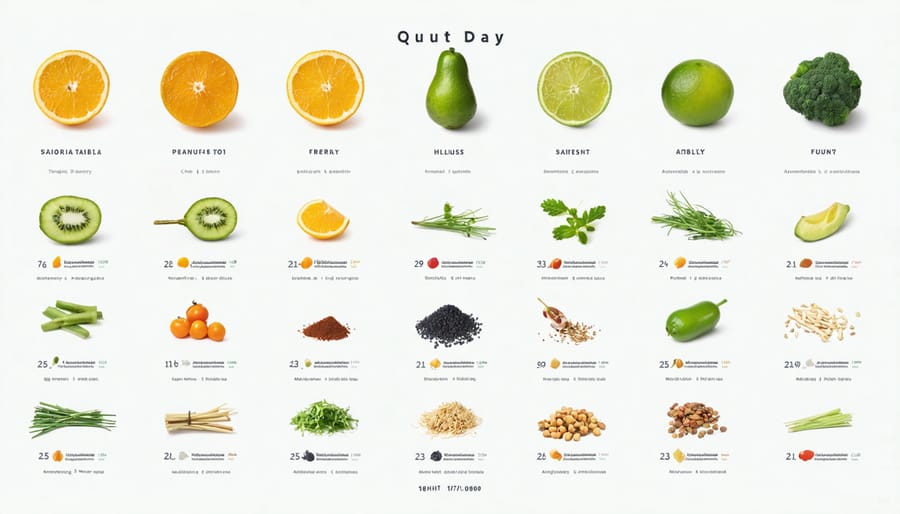
Your 7-Day Seasonal Meal Prep Blueprint
Weekend Prep Day
Sunday is your powerhouse day for efficient meal preparation, setting you up for a week of stress-free cooking. I remember when I first started meal prepping, I felt overwhelmed by all the tasks ahead, but breaking it down into manageable steps made all the difference.
Start by clearing your kitchen counters and gathering all your containers. Trust me, having an organized workspace makes everything flow so much better! Put on your favorite playlist or podcast – this is your time to enjoy the process.
Begin with your proteins since they typically take the longest to cook. While your chicken, fish, or plant-based proteins are in the oven, move on to washing and chopping vegetables. I like to create veggie stations: one for roasting, one for raw snacking, and one for quick-cooking items later in the week.
Next, tackle your grains and legumes. Cook a big batch of quinoa, brown rice, or whatever grains you enjoy. These will form the foundation of many meals throughout the week. While these are simmering, prepare any sauces or dressings you’ll need – store them in small containers or mason jars.
Don’t forget to prep some healthy snacks! Cut up fruit, portion out nuts, or make energy balls. Having these ready to grab will save you from reaching for less nutritious options when hunger strikes mid-week.
As everything cools, start portioning your meals into containers. I find it helpful to leave some components separate for variety – this way, you can mix and match throughout the week. Label everything with dates, especially if you’re freezing portions.
Remember to clean as you go – this makes the final cleanup much more manageable. The whole process usually takes about 2-3 hours, but this investment saves countless hours during the busy week ahead.
A quick tip I’ve learned: Keep a running list on your phone of what you’ve prepped. This helps you remember what’s available and prevents food waste. Some weeks might feel more challenging than others, but remember that any prep is better than none!

Mid-Week Mini Prep
Let’s talk about the secret to keeping your meal prep fresh and exciting all week long – the mid-week mini prep! I discovered this game-changing approach after years of finding my carefully prepped meals losing their appeal by Thursday, and trust me, it’s been a total transformation.
Think of your mid-week refresh as a quick pit stop, usually on Wednesday evening, taking just 30-45 minutes. This is your chance to revive your remaining meals and prep any fresh elements that don’t hold up well for a full week. I like to use this time to chop fresh herbs, prepare additional salad greens, or cook a new batch of grains that will carry me through to Sunday.
Here’s my tried-and-true approach to the mid-week refresh:
1. Take inventory of what’s left from your Sunday prep
2. Give your prepped containers a quick wipe-down
3. Prepare any fresh elements that are starting to wilt
4. Cook one or two quick items to add variety
5. Reorganize your fridge for the remaining days
Pro tip: Keep a small collection of “refresh ingredients” ready to go. Think crispy vegetables like snap peas or radishes, fresh herbs, and squeeze-on sauces that can instantly upgrade your pre-prepped meals. Sometimes, just adding a different sauce or a handful of fresh greens can make Thursday’s lunch feel brand new.
Remember, this isn’t about redoing your entire meal prep – it’s a quick tune-up to maintain freshness and excitement in your meals. I often use this time to incorporate any seasonal produce I picked up at the mid-week farmers’ market, adding that farm-to-table touch that makes meals feel special.
The mid-week mini prep isn’t just about food maintenance; it’s your opportunity to adjust portions, swap ingredients if needed, and ensure nothing goes to waste. It’s amazing how this small investment of time can make such a big difference in your week-long meal prep success!
Storage and Organization Tips
Let me share a game-changing tip I learned early in my meal prep journey: proper storage is just as important as the cooking itself! Think of your prepped meals as tiny treasures that need the right home to stay fresh and delicious all week long.
Start with investing in quality glass containers – they’re my absolute favorite for keeping food fresh and preventing any unwanted flavors from seeping in. I organize mine with clear labels showing both the contents and date of preparation, which has saved me from many “is this still good?” moments!
For maximum freshness, layer your ingredients strategically. Keep wet ingredients separate from dry ones, and always place heavier items at the bottom of your containers. Those crispy vegetables you worked so hard to prepare? Store them with a paper towel to absorb excess moisture and maintain their crunch.
Here’s a pro tip that changed my meal prep game: designate specific shelves in your fridge for different days of the week. I keep Monday through Wednesday meals at eye level and Thursday through Sunday below. This simple system helps track what needs to be eaten first and prevents food waste.
When it comes to storing prepared proteins, remember they typically stay fresh for 3-4 days in the refrigerator. If you’re prepping for a full week, consider freezing portions for the latter part of the week and thawing them the night before.
For salads and fresh vegetables, store dressings and sauces separately in small containers. This prevents soggy greens and keeps everything tasting as fresh as day one. Trust me, your Thursday self will thank you for this extra step!
Mindful Eating Practices Throughout the Week
Mindful eating transforms our meal prep journey from a routine task into a meaningful ritual. As someone who used to rush through meals while scrolling on my phone, I’ve discovered that bringing awareness to our food preparation and consumption can dramatically enhance our overall relationship with food.
Start by creating a peaceful environment for your meals. Turn off notifications, set the table thoughtfully, and take a moment to appreciate the colors and aromas of your prepared dishes. Before each meal, practice taking three deep breaths to center yourself and transition into a more present state of mind.
Throughout the week, try incorporating these simple mindful eating practices:
• Take small bites and chew thoroughly, noticing the different flavors and textures
• Put your utensils down between bites
• Check in with your hunger levels before, during, and after eating
• Express gratitude for your meal and the effort that went into preparing it
• Notice how different foods affect your energy and mood
When meal prepping, engage all your senses. Feel the different textures of fresh produce, listen to the sounds of chopping and sizzling, and observe how ingredients transform during cooking. This awareness not only makes the process more enjoyable but also helps you create more flavorful meals.
Remember, mindful eating isn’t about perfect execution – it’s about building a more conscious relationship with food. Even taking just five mindful bites during a busy lunch break can make a difference. Start small, be patient with yourself, and watch how these simple practices enhance your weekly meal prep experience.
Troubleshooting Common Challenges
Managing Produce Shelf Life
Keeping your produce fresh throughout the week is crucial for successful meal prep. I’ve learned through trial and error that proper storage makes all the difference in maintaining flavor and nutrients. Start by investing in quality eco-friendly food storage containers that allow proper airflow. Store leafy greens with a paper towel to absorb excess moisture, and keep herbs fresh by treating them like flowers in a glass of water with a loose plastic bag over top. Root vegetables thrive in cool, dark places, while tomatoes and avocados should stay on the counter until ripe. Remember to wash berries just before using them, not during prep, to prevent mold. For longer-lasting citrus fruits, keep them in the crisper drawer of your fridge. One of my favorite tricks is to separate ethylene-producing fruits (like apples and bananas) from ethylene-sensitive produce to prevent premature ripening.
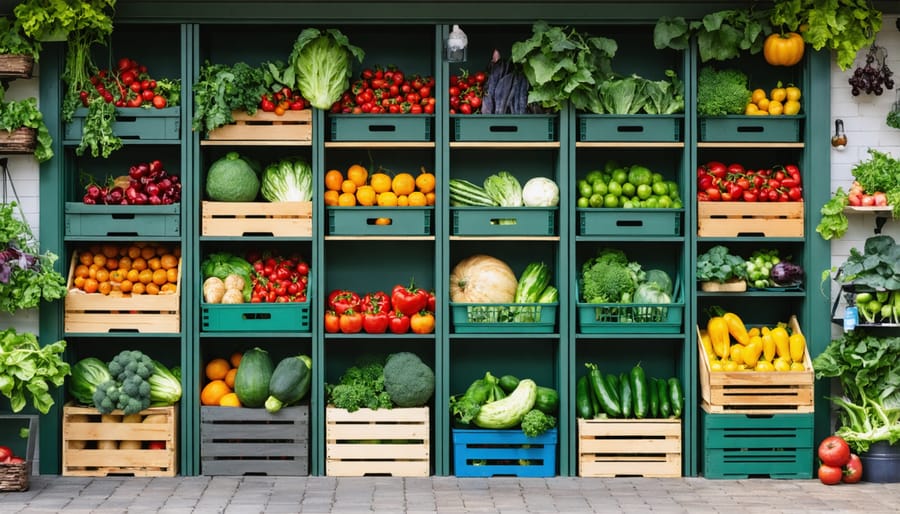
Adapting to Seasonal Changes
As the seasons shift, so should your meal prep strategy. I’ve learned that embracing seasonal produce not only saves money but also ensures we’re getting the freshest, most nutritious ingredients. In summer, I focus on preparing light, refreshing meals with abundant fresh vegetables and fruits, often incorporating no-cook elements like crisp salads and cold soups. When autumn rolls around, I transition to heartier ingredients and warming dishes, utilizing root vegetables and seasonal squashes.
Keep your pantry stocked with versatile staples that work year-round, but adjust your shopping list to include what’s currently in season. During winter months, I lean towards slow-cooker meals and roasted vegetables, while spring calls for tender greens and early harvests. This flexible approach helps maintain variety in your meal prep routine while working with nature’s rhythm. Remember to gradually transition between seasons, mixing familiar recipes with seasonal adaptations to keep your meal prep exciting and sustainable.
Starting your 7-day meal prep journey might feel like a big step, but remember that every mindful choice you make towards better planning and seasonal eating is a win worth celebrating. By embracing seasonal ingredients and thoughtful preparation, you’re not just saving time and money – you’re creating a more sustainable and connected relationship with your food.
I’ve seen firsthand how meal prep can transform busy weeks into smoother, more enjoyable experiences. From my own journey, I can tell you that it gets easier with each passing week. Start small if you need to – maybe prep just your lunches for the first week, then gradually add more meals as you build confidence.
Remember, there’s no one-size-fits-all approach to meal prep. Make these guidelines your own, adjust portions to suit your needs, and don’t be afraid to experiment with seasonal ingredients that speak to you. The key is finding a rhythm that works for your lifestyle while staying connected to nature’s calendar.
Ready to begin? Your future self will thank you for taking this step towards more mindful, organized, and seasonal eating. Let’s make every meal count!

